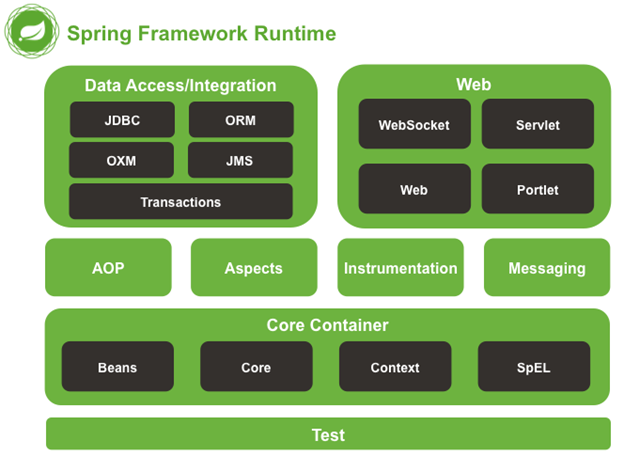What is Spring Framework
- Spring is a lightweight and open source framework
- The Spring Framework is a Java platform that provides comprehensive infrastructure support for developing Java applications
- Unlike struts and hibernate, Spring framework can be used for all layer implementations for areal time
- Spring framework is said to be anon-invasive means it doesn’t force a programmer to extend or implement their class from any predefined class or interface given by Spring API
- Spring Framework made J2EE application development little easier, by introducing a POJO model
- Spring is a popular and demanded framework because of Simplicity, Testability and Loose Coupling
- Spring can be used to develop any kind ofJava application, means we can develop starting from console application to enterprise level application.
Some of the benefits of spring platform
- Make a Java method execute in a database transaction without having to deal with transaction APIs.
- Make a local Java method a remote procedure without having to deal with remote APIs.
- Make a local Java method a management operation without having to deal with JMX APIs.
- Make a local Java method a message handler without having to deal with JMS APIs.
Spring Modules
The Spring Framework consists of features organized into about 20 modules. These modules are grouped into the Core Container, Data Access/Integration, Web, AOP (Aspect Oriented Programming), Instrumentation, Messaging, and Test, as shown in the following diagram.

Core Container
The Core Container consists of the spring-core, spring-beans, spring-context, spring-context-support, and spring-expression (Spring Expression Language) modules.
The spring-core and spring-beans modules provide the fundamental parts of the framework, including the IoC and Dependency Injection features. The BeanFactory is a sophisticated implementation of the factory pattern. It removes the need for programmatic singletons and allows you to decouple the configuration and specification of dependencies from your actual program logic.
The Context (spring-context) module builds on the solid base provided by the Core and Beans modules: it is a means to access objects in a framework-style manner that is similar to a JNDI registry. The Context module inherits its features from the Beans module and adds support for internationalization (using, for example, resource bundles), event propagation, resource loading, and the transparent creation of contexts by, for example, a Servlet container. The Context module also supports Java EE features such as EJB, JMX, and basic remoting. The ApplicationContext interface is the focal point of the Context module. spring-context-support provides support for integrating common third-party libraries into a Spring application context for caching (EhCache, Guava, JCache), mailing (JavaMail), scheduling (CommonJ, Quartz) and template engines (FreeMarker, JasperReports, Velocity).
The spring-expression module provides a powerful Expression Language for querying and manipulating an object graph at runtime. It is an extension of the unified expression language (unified EL) as specified in the JSP 2.1 specification. The language supports setting and getting property values, property assignment, method invocation, accessing the content of arrays, collections and indexers, logical and arithmetic operators, named variables, and retrieval of objects by name from Spring’s IoC container. It also supports list projection and selection as well as common list aggregations.
AOP and Instrumentation
The spring-aop module provides an AOP Alliance-compliant aspect-oriented programming implementation allowing you to define, for example, method interceptors and pointcuts to cleanly decouple code that implements functionality that should be separated. Using source-level metadata functionality, you can also incorporate behavioral information into your code, in a manner similar to that of .NET attributes.
The separate spring-aspects module provides integration with AspectJ.
The spring-instrument module provides class instrumentation support and classloader implementations to be used in certain application servers. Thespring-instrument-tomcat module contains Spring’s instrumentation agent for Tomcat.
Messaging
Spring Framework 4 includes a spring-messaging module with key abstractions from the Spring Integration project such as Message, MessageChannel, MessageHandler, and others to serve as a foundation for messaging-based applications. The module also includes a set of annotations for mapping messages to methods, similar to the Spring MVC annotation based programming model.
Data Access/Integration
The Data Access/Integration layer consists of the JDBC, ORM, OXM, JMS, and Transaction modules.
The spring-jdbc module provides a JDBC-abstraction layer that removes the need to do tedious JDBC coding and parsing of database-vendor specific error codes.
The spring-tx module supports programmatic and declarative transaction management for classes that implement special interfaces and for all your POJOs (Plain Old Java Objects).
The spring-orm module provides integration layers for popular object-relational mapping APIs, including JPA, JDO, and Hibernate. Using the spring-orm module you can use all of these O/R-mapping frameworks in combination with all of the other features Spring offers, such as the simple declarative transaction management feature mentioned previously.
The spring-oxm module provides an abstraction layer that supports Object/XML mapping implementations such as JAXB, Castor, XMLBeans, JiBX and XStream.
The spring-jms module (Java Messaging Service) contains features for producing and consuming messages. Since Spring Framework 4.1, it provides integration with the spring-messaging module.
Web
The Web layer consists of the spring-web, spring-webmvc, spring-websocket, and spring-webmvc-portlet modules.
The spring-web module provides basic web-oriented integration features such as multipart file upload functionality and the initialization of the IoC container using Servlet listeners and a web-oriented application context. It also contains an HTTP client and the web-related parts of Spring’s remoting support.
The spring-webmvc module (also known as the Web-Servlet module) contains Spring’s model-view-controller (MVC) and REST Web Services implementation for web applications. Spring’s MVC framework provides a clean separation between domain model code and web forms and integrates with all of the other features of the Spring Framework.
The spring-webmvc-portlet module (also known as the Web-Portlet module) provides the MVC implementation to be used in a Portlet environment and mirrors the functionality of the spring-webmvc module.
Test
The spring-test module supports the unit testing and integration testing of Spring components with JUnit or TestNG. It provides consistent loading of Spring ApplicationContexts and caching of those contexts. It also provides mock objects that you can use to test your code in isolation.
Resource from: https://docs.spring.io/spring-framework/docs/current/spring-framework-reference/html/overview.html
